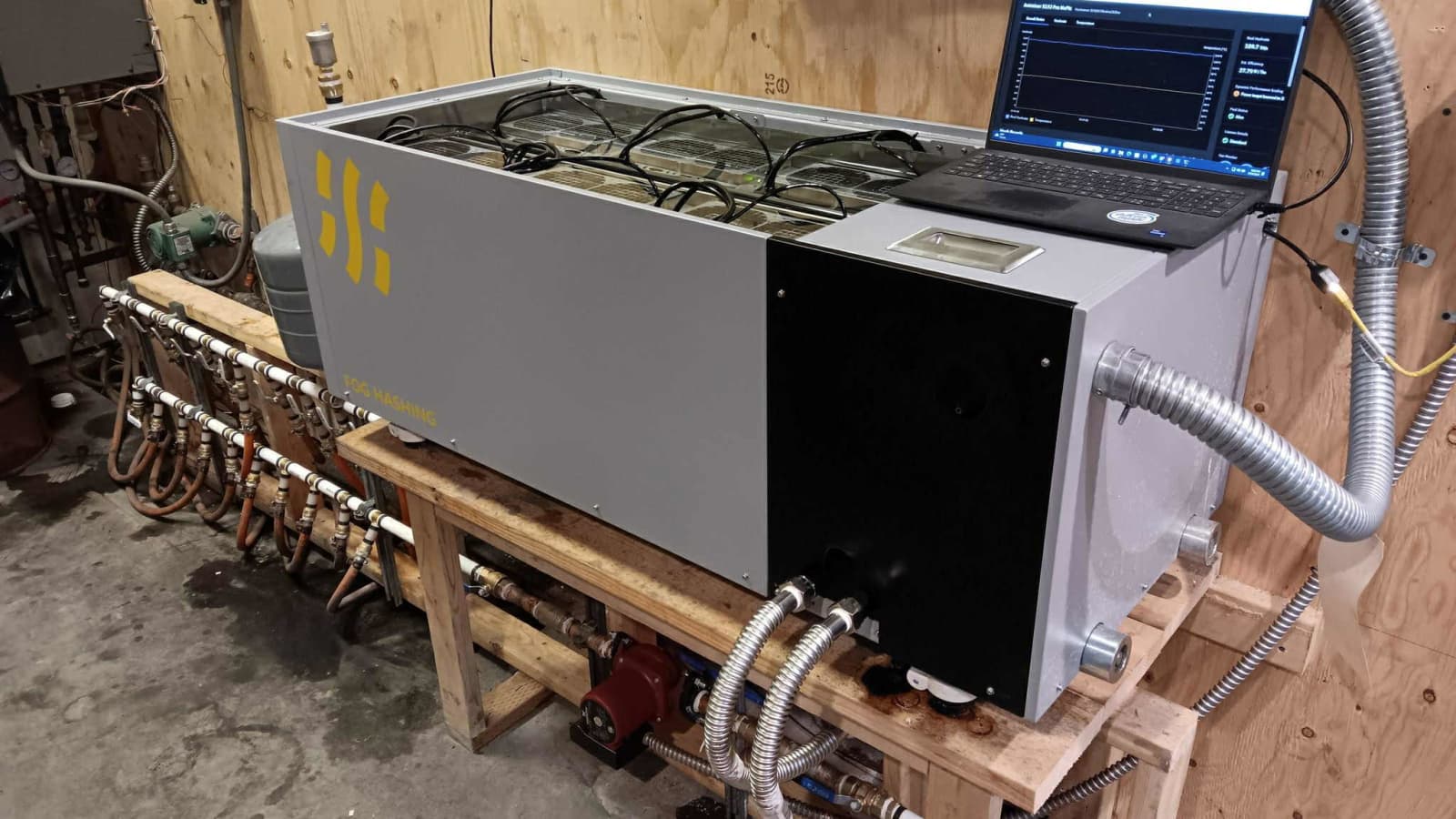Americans Turn to Bitcoin Mining for Home Heating
Americans Turn to Bitcoin Mining for Home Heating
By
Calder Monroe
Last updated:
November 17, 2025
First Published:
November 17, 2025

A bitcoin mining rig used to heat a 2,400 square foot building.
Softwarm
A New Approach to Staying Warm
As winter drives temperatures lower and utility bills higher, a small but rapidly growing group of Americans is experimenting with an unconventional heat source. Instead of relying solely on natural gas, oil, or electric furnaces, some are using the excess heat generated by cryptocurrency mining to warm their homes — transforming a once-wasted byproduct into usable energy.
According to an analysis by digital assets brokerage K33, bitcoin mining produces an estimated 100 terawatt-hours of heat annually, enough to warm every household in Finland for a year. Traditionally, nearly all of this heat has been lost into the atmosphere. Now, rising energy costs and improved hardware efficiency are pushing innovators to recapture that heat and put it to work.
This emerging concept has already given rise to new products like the HeatTrio, a $900 space heater that doubles as a bitcoin mining rig, and has inspired many DIY miners to reroute the heat from their machines directly into home ventilation systems.
How Bitcoin Warmth Works
Crypto mining computers generate heat as a byproduct of solving complex mathematical problems. In cold regions, this heat can be redirected to offset traditional heating expenses.
Jill Ford, CEO of Dallas-based sustainable mining firm Bitford Digital, says this practice is more common than people realize.
“I’ve seen rigs running quietly in attics, with heat redirected through the home’s vents to reduce heating costs,” Ford said. “When used creatively, miners can be energy allies — you’re already paying for electricity, so why waste the heat?”
Although using mining rigs won’t necessarily lower a household’s electric bill, they can offset heating costs while generating bitcoin. A single machine — even an older model — often produces enough heat to warm multiple rooms, and many solo miners join pools where computing power is shared and earnings are distributed more predictably.
Industry innovators are especially excited about large-scale opportunities. Andrew Sobko, founder of Argentum AI, explains that crypto heat repurposing is most effective in bigger buildings, data centers, and greenhouses where heat demand is constant.
“We’re already working with partners redirecting compute heat into heating systems for buildings and agricultural facilities,” Sobko said. “Instead of moving heat long distances, you simply move the compute closer to where the heat is needed.”
Why Some Experts Remain Skeptical
Despite the enthusiasm, many economists and energy analysts warn that this trend is being oversold.
Derek Mohr, a clinical associate professor at the University of Rochester, argues that the modern bitcoin mining landscape is too competitive for households to benefit meaningfully.
“Home computers haven’t been viable for meaningful bitcoin mining in over a decade,” Mohr said. “Mining farms use highly specialized chips that work far faster than anything a homeowner can afford.”
Mohr also notes that many “crypto heaters” on the market are essentially expensive space heaters. They consume electricity to produce heat — just like any heater — but with only a small chance of mining enough bitcoin to justify the cost.
To him, it’s “not a real opportunity” for most households, and he fears people may be misled by hype around excess mining heat and imagined profits from home mining setups.
However, other experts say advancements in plug-and-play mining equipment and more efficient chips may eventually reduce barriers and make the economics more favorable.
Crypto Heat’s Potential Future
At Texas Christian University’s Ralph Lowe Energy Institute, Executive Director Nikki Morris believes the concept deserves deeper research.
Because mining produces a digital asset that can be traded, it introduces a secondary revenue stream from power consumption. That revenue, combined with usable heat, could transform how homes and businesses think about energy efficiency.
“Imagine a mixed-use building where crypto mining provides both digital currency and heat,” Morris said. “That’s a step toward distributed energy innovation, complementing renewable systems and lowering strain on existing infrastructure.”
TCU researchers are studying how crypto heat can integrate with solar, wind, battery storage, and even EV charging systems. Morris emphasizes the long-term view: “This isn’t just a quirky trend — it’s a glimpse into how digital and physical energy systems might converge.”
Real-World Testing in Idaho
In Challis, Idaho, this future is already being tested. Local entrepreneur Cade Peterson, founder of Softwarm, is helping residents heat their businesses with bitcoin miners.
Peterson says several local shops now heat their spaces using mining rigs. At TC Car, Truck and RV Wash, the owner previously paid $25 per day to heat wash bays in winter. After installing miners, the business now generates more in bitcoin revenue than the electricity cost required to run the miners.
Another company — an industrial concrete business — has begun heating its 2,500-gallon water tank using mining rigs, significantly reducing a $1,000 monthly heating bill.
Peterson has heated his own home for over two years this way and predicts widespread adoption.
“In a few years, you’ll walk into a big-box store and buy a water heater with a data port,” he says. “Your water will be heated with bitcoin — it’s inevitable.”
The Road Ahead
While crypto-powered heating is still in its early stages, advancements in mining efficiency, growing environmental interest in heat recapture, and high winter energy costs are accelerating research and adoption.
Whether this becomes a mainstream heating method or remains a niche innovation, one fact is clear: the heat generated by digital currency mining is no longer being ignored.
As energy systems evolve, the intersection of power consumption, digital assets, and real-world utility may reshape how Americans think about both heating and technology in the decades ahead.
Popular articles
Subscribe to unlock premium content
How Adults Are Paying to Experience Silent Daylong Festivals for Mindfulness

The Rise of Ultra-Personalized Scent Memory Experiences Using Olfactory Therapy

Why Some Millennials Are Paying for One-Day Luxury Survival Challenges in Nature

How Adults Are Paying to Experience Silent Daylong Festivals for Mindfulness

The Rise of Ultra-Personalized Scent Memory Experiences Using Olfactory Therapy

How Adults Are Paying to Experience Silent Daylong Festivals for Mindfulness







.png)

